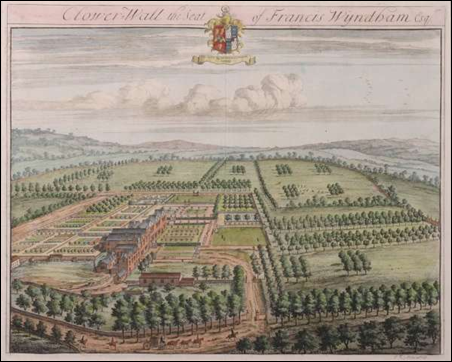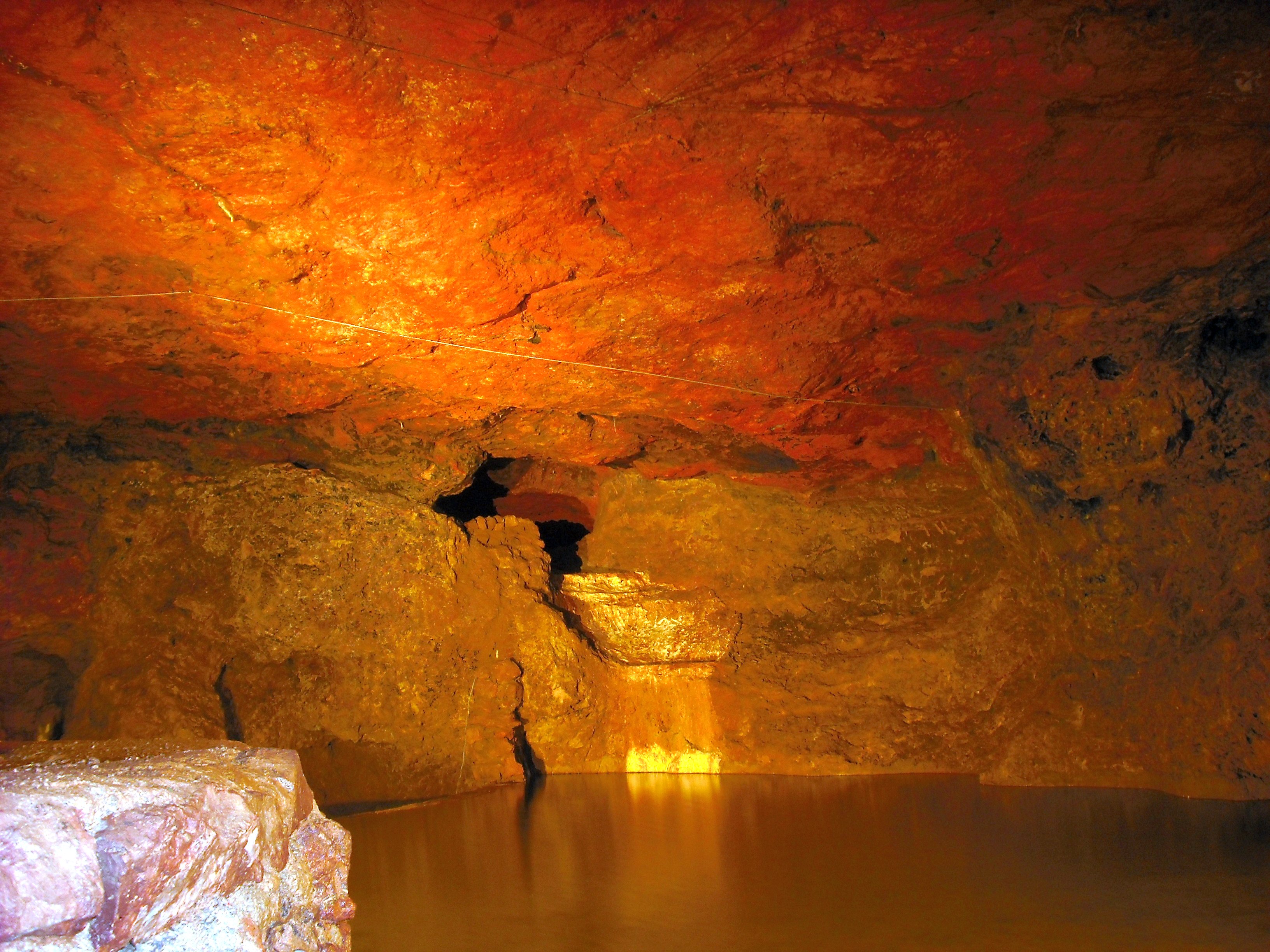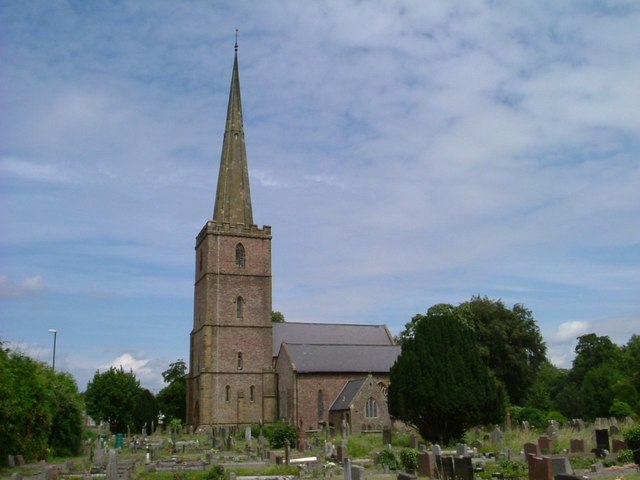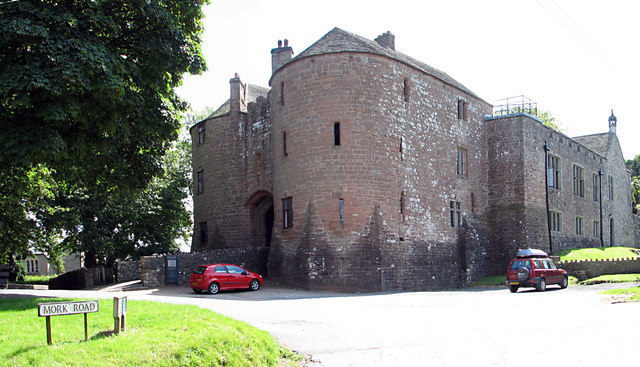|
Clearwell
Clearwell (anciently "Clower-Wall" etc.) is a village and former ancient manor in the Forest of Dean, West Gloucestershire, England. A recent survey indicated that the population of Clearwell is approximately 350. There are mines locally that date back over 7,000 years to the mining of ochre and are known as Clearwell Caves. Later, the Romans mined iron at Clearwell Meend. Iron production expanded in medieval times and peaked in the 16th and 17th centuries, leaving a legacy of fine stone built buildings. Clearwell Castle, a 'mock' castle of Gothic architecture built in 1728, is located in Clearwell. History of the village The village of Clearwell began as a group of hamlets which coalesced to form the village. It formed around three roads which run down shallow valleys to a central junction. The hamlets on the three roads were Clearwell, Peak, and Platwell, with a fourth hamlet, Wainlete, to the north-west of Clearwell. Clearwell and Platwell had dwellings by around 1300. In 1 ... [...More Info...] [...Related Items...] OR: [Wikipedia] [Google] [Baidu] |
Clearwell Caves
Clearwell Caves, at Clearwell in the Forest of Dean, Gloucestershire, England, is a natural cave system which has been extensively mined for iron ore. It now operates primarily as a mining museum. The caves are part of a Natural England designated Site of Special Scientific Interest and the notification includes parts of Clearwell along with Old Bow, Lambsquay and Old Ham mine complexes. Mining Clearwell Caves are a collection of six mines: Clearwell, Old Ham, Lambsquay, Old Bow, Oak Pit and New Dun, covering approximately 250 acres. The interconnected cave systems were formed by underground streams from around 180 million years ago. They have been mined originally for ochre, then for iron ore from Iron Age times Circa 100BC increasing from Roman times and extensively during the 19th century, which considerably enlarged and extended the network of natural caverns. Ochre has been mined here for even longer. The nearby scowles at the Secret Forest and Puzzlewood represent s ... [...More Info...] [...Related Items...] OR: [Wikipedia] [Google] [Baidu] |
Clearwell Castle
Clearwell Castle in Clearwell, the Forest of Dean, Gloucestershire, is a Gothic Revival house constructed from 1727. Built by Thomas Wyndham to the designs of Roger Morris, it is the earliest Georgian Gothic Revival castle in England predating better-known examples such as Strawberry Hill House by over twenty years. A home of the Wyndham family for some 150 years, the first half of the twentieth century saw a disastrous fire, and subsequent asset-stripping, which brought the castle close to ruination. Slowly restored from 1954, in the 1970s the castle housed a recording studio used by, among other major bands, Black Sabbath, Led Zeppelin, Deep Purple, Bad Company, Queen and Sweet. Now operating as a wedding venue, the castle is a Grade II* listed building. History Thomas Wyndham (1686–1752), the son of Francis Wyndham, a wealthy landowner, and Sarah Darell, was educated at Eton and the University of Cambridge, and became a barrister and later a Member of Parliament. He married ... [...More Info...] [...Related Items...] OR: [Wikipedia] [Google] [Baidu] |
Forest Of Dean District
Forest of Dean is a local government district in Gloucestershire, England, named after the Forest of Dean. Its council is based in Coleford. Other towns and villages in the district include Blakeney, Cinderford, Drybrook, English Bicknor, Huntley, Littledean, Longhope, Lydbrook, Lydney, Mitcheldean, Newnham and Newent. The district was formed on 1 April 1974 under the Local Government Act 1972, as a merger of the East Dean Rural District, Lydney Rural District, Newent Rural District and West Dean Rural District, and from Gloucester Rural District the parishes of Newnham and Westbury-on-Severn. Parishes and settlements * Alvington, Awre, Aylburton *Blaisdon, Bream, Brockweir, Bromsberrow, Blakeney *Churcham, Cinderford, Coleford *Drybrook, Dymock * Ellwood, English Bicknor *Gorsley and Kilcot *Hartpury, Hewelsfield, Highleadon, Huntley *Kempley *Littledean, Little London, Longhope, Lydbrook, Lydney *Mitcheldean *Newent, Newland, Newnham *Oxenhall * Pauntl ... [...More Info...] [...Related Items...] OR: [Wikipedia] [Google] [Baidu] |
Bitton
Bitton is a village and civil parish of South Gloucestershire in England, to the east of the Greater Bristol area on the River Boyd. It is in South Gloucestershire. The parish of Bitton has a population of 9,307, and apart from the village itself, includes Swineford, Upton Cheyney, Beach, Oldland Common, North Common and part of Willsbridge. Governance An electoral ward with the same name exists. This ward does not cover as much of the outskirts of Bristol as the parish. The total population of the ward taken at the 2011 census is 3,509. Transport The A431 road runs through the village. Beyond Bitton the road routes north-west to Willsbridge and south-east to Kelston. The heritage Avon Valley Railway is based at Bitton railway station. The National Cycle Network Bristol and Bath Railway Path runs alongside the railway. Bus Routes 19, 37, 441, 443 and 684 run down the A431 and go towards Bath and bristol City Centres and suburbs. Sport Bitton A.F.C. are the local ... [...More Info...] [...Related Items...] OR: [Wikipedia] [Google] [Baidu] |
Lydney
Lydney is a town and civil parish in Gloucestershire, England. It is on the west bank of the River Severn in the Forest of Dean District, and is 16 miles (25 km) southwest of Gloucester. The town has been bypassed by the A48 road since 1995. The population was about 8,960 in the 2001 census, reducing to 8,766 at the 2011 census. Increasing to 10,043 at the 2021 Census. Lydney has a harbour on the Severn, created when the Lydney Canal was built. Adjoining the town, Lydney Park gardens have a Roman temple dedicated to Nodens. Etymology According to Cook (1906) the toponym "Lydney" derives from the Old English *''Lydan-eġ'', "Lludd's Island", which could connect it with the name Nudd/Nodens. However, alternative etymologies of Lydney are offered in other sources. A. D. Mills suggests "island or river-meadow of the sailor, or of a man named *Lida", citing the forms "Lideneg" from c. 853 and "Ledenei" from the 1086 Domesday Book. History In the Iron Age a promontory fort w ... [...More Info...] [...Related Items...] OR: [Wikipedia] [Google] [Baidu] |
Thomas Baynham (d
Thomas Baynham (1536-1611) was Lord of the Manor of Clearwell, in the Forest of Dean, Gloucestershire. He served as Sheriff of Gloucestershire in 1582 and 1602. He died on 2 October 1611, aged 75, and was buried at Newland, Gloucestershire. Origins He was the 3rd son of Sir George Baynham (died 1546), Sheriff of Gloucestershire in 1543, by Cecilia Gage, daughter of Sir John Gage. He succeeded his elder brother Christopher Baynham (born 1529) in the Baynham estates. Marriage and progeny He married Mary Winter, daughter of William Winter of Lydney, Gloucestershire. They had two sons who both died without issue and two daughters, joint-co-heiresses: *Cecily, married Sir William Throckmorton, 1st Baronet(c. 1579-1628), of Tortworth Tortworth is a small village and civil parish, near Thornbury, South Gloucestershire, Thornbury in Gloucestershire, England. It has a population of 147 as of 2011. It lies on the B4509 road, which crosses the M5 motorway to the west of Tortworth. ..., G ... [...More Info...] [...Related Items...] OR: [Wikipedia] [Google] [Baidu] |
High Sheriff Of Gloucestershire
This is a list of Sheriffs and High Sheriffs of Gloucestershire, who should not be confused with the Sheriffs of the City of Gloucester. The High Sheriff is the oldest secular office under the Crown (in England and Wales the office previously known as sheriff was retitled High Sheriff on 1 April 1974). Formerly the Sheriff was the principal law enforcement officer in the county but over the centuries most of the responsibilities associated with the post have been transferred elsewhere or are now defunct, so that the High Sheriff's functions are now largely ceremonial. The High Sheriff changes every March. As of 2006, the Sheriff's territory or bailiwick is covered by the administrative areas of Gloucestershire County Council and of South Gloucestershire District Council. Sir Robert Atkyns, the historian of Gloucester, writing in 1712 stated that no family had produced more Sheriffs of this county than Denys. Sheriffs 12th and 13th century *1071–c. 1082: Roger de Pitres (R ... [...More Info...] [...Related Items...] OR: [Wikipedia] [Google] [Baidu] |
Alveston
Alveston is a village, civil parish and former royal manor in South Gloucestershire, England, inhabited in 2014 by about 3,000 people. The village lies south of Thornbury and north of Bristol. Alveston is twinned with Courville sur Eure, France. The civil parish also includes the villages of Rudgeway and Earthcott. Stone Age A scheduled Round barrow is situated next to Vattingstone Lane on the summit of the prominent hill called Alveston Down. The barrow survives as a circular flat-topped mound measuring approximately 25m in diameter and 1m high. The barrow is known in old documents by the place name 'Langeley' and is mentioned in charters as a meeting place for the Anglo-Saxon Hundred when it was re-used as a moot. It was partially excavated in 1890 when a primary deposit of ashes and burnt bone was discovered beneath a covering of sand and small stones. Iron Age A ritual deposit of bones, dating to about 2000 years ago, has been found in a cave in the village. ... [...More Info...] [...Related Items...] OR: [Wikipedia] [Google] [Baidu] |
Baynham Arms, Saint Michael And All Angels, Mitcheldean, Gloucestershire, UK - 20100712
Baynham is a surname with its origins in the United Kingdom and with the variations of Baynam, Bayham, Bynum, Beniams, and Byneham. History and origins The Baynham name can be traced back to the Surname 1380 in the form of Ap Eynon. The name is therefore of origin. There has been a multitude of nobles who have held the surname, and the name has a . Notable people sharing the surname "Baynham" * Albert Baynham, English footballer *[...More Info...] [...Related Items...] OR: [Wikipedia] [Google] [Baidu] |
St Briavel's Castle
St Briavels Castle is a moated Norman castle at St Briavels in the English county of Gloucestershire. The castle is noted for its huge Edwardian gatehouse that guards the entrance. St Briavels Castle was originally built between 1075 and 1129 as a royal administrative centre for the Forest of Dean. During the 13th century the castle became first a favourite hunting lodge of King John, and then the primary centre in England for the manufacture of quarrels, large numbers of which were required for crossbows in medieval warfare. The castle was transferred many times between royal favourites in the 14th and 15th centuries and slowly declined in appearance and importance. St Briavels Castle became used primarily as a court and as a notorious debtors' prison, conditions being documented by the prison reformer John Howard in 1775. Following local riots and a parliamentary investigation in the 1830s, reforms in the 19th century brought an end to the castle's use as a prison. Extensive ... [...More Info...] [...Related Items...] OR: [Wikipedia] [Google] [Baidu] |
John Tiptoft, 1st Earl Of Worcester
John Tiptoft, 1st Earl of Worcester KG (8 May 1427 – 18 October 1470), was an English nobleman and scholar who served as Lord High Treasurer, Lord High Constable of England and Lord Deputy of Ireland. He was known as "the Butcher of England" to his Tudor detractors. Life Birth and education Born at Eversden in 1427, he was the son of John Tiptoft, 1st Baron Tiptoft, and Joyce Cherleton, co-heiress of Edward Charleton, 5th Baron Cherleton. He was notable for his education, studying at University College at Oxford University from the ages of 13 to 16. Through his father, he was a descendant of Charlemagne and through his mother he was a descendant of Llywelyn the Great and Henry III of England. Marriages and children He married thrice: # Cecily Neville, Duchess of Warwick, daughter of Richard Neville, 5th Earl of Salisbury, in 1449, by whom he had no issue. She died 28 July 1450. #Elizabeth Greyndour (d. 1452), daughter and sole heiress of Robert (d. 1443) of and J ... [...More Info...] [...Related Items...] OR: [Wikipedia] [Google] [Baidu] |






